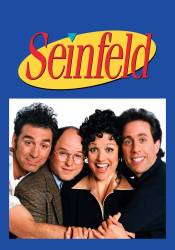Factual error: At the end of the episode in which George and Susan get engaged, they are lying in bed together watching "Mad About You" on TV. However, at some earlier point on "Mad About You" it had been established in a crossover episode that Paul Reiser was the person who lived in Jerry's apartment before him and was an old acquaintence of Kramer's, meaning that "Seinfeld" and "Mad About You" existed in the same reality. On "Seinfeld," the show "Mad About You" could not exist.
The Sponge - S7-E9
Factual error: During the AIDS walk there is an officer seen several times with a patch "Transit Police, NYC." Not only is the patch completely fictional, it doesn't look anything like the real transit police logo. The Transit Police had already been defunct by the time of this episode.
The Calzone - S7-E20
Factual error: When Jerry gets a speeding ticket, he asks Nicki to give the officer the registration. She gets a large piece of white paper from the glove compartment. That's what car registrations look like in California, where the show was produced. In New York, where it's supposed to take place, car registrations are the size of a driver's license, and are usually kept in the driver's wallet.






Answer: Composer Jonathan Wolff used a synthesizer, although in seasons 7-9, a real bass is used in addition. Wolff also recorded himself making hundreds of mouth noises, pops, and slaps to add to the synthesized bass licks so that each episode has a different theme. The only real "back-story" is Jerry Seinfeld was having trouble coming up with a theme song and talked to a friend who happened to know Wolff. They wanted to avoid that cheesy late 80's sit-com theme song and Wolff came up with what we enjoy now. Jonathan Wolff has also talked about this further in interviews, recently Reed Dunela interviewed him, so for a fuller account of his story; check out "The Wolff of 116th street".
Bishop73